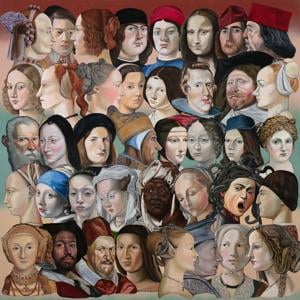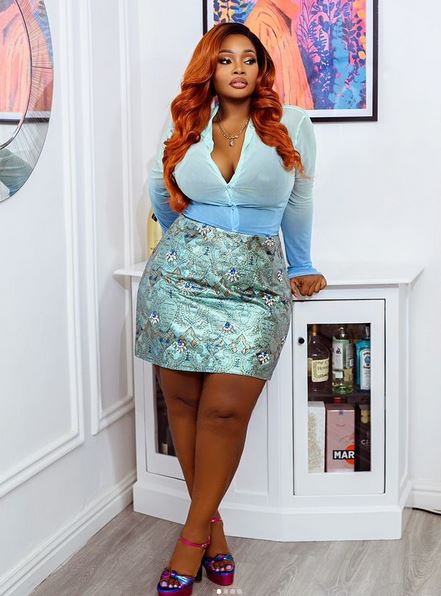
Leonardo da Vinci’s "Mona Lisa," Johannes Vermeer’s "Girl with a Pearl Earring" and Caravaggio’s "Medusa" stare out among 40 headshot views of 40 subjects of famous paintings in “There’s a price on your head.” Sausages, fish and slabs of beef and pork lifted from 17th-century Dutch still-life paintings cover “You’re Dead” and moss grows over a classic oval painting of women in a "Lady Lichen" series. Those paintings are — to use the title of Melissa Furness’ Kiechel Fine Arts exhibition, “Historical Rubbish" — elements that typify her conceptual approach to painting that recontextualizes imagery from art history by throwing them into piles.
Melissa Furness' "There's a price on your head" combines 40 subjects from famous paintings. That process of turning the images into “rubbish” identifies the meat, bread, clothing and generic body forms as the cliches that they are and, simultaneously, eliminates the preciousness of the historically revered artwork and degrades the Western ideal of art. Furness, a University of Colorado Denver professor who teaches painting and drawing, also uses her work to examine the imagery’s historical and cultural context, writing in her artist’s statement: “Each series of work that I have produced is related through an exploration of distortions of history.

The work calls into question selections of what it is that is upheld or kept and cherished versus what is discarded or thrown out and unwanted. These elements tell a story, from what a larger public or political body chooses to show to the world versus the reality of the local and personal life of a people or individual.” The 17th-century still life works, for example, come from a time when the Dutch were at the center of European mercantile trade, and many of the paintings' objects — hats, clothing and some of the food — reflect the development of the world’s first consumer society and its grasping of desirous things that continues today.
“Caput mortuum” examines Renaissance painting in a different fashion, with its intertwined bodies reflecting the all-male modeling of the era that led to, as Furness demonstrates, overly muscled women with breasts clearly attached to the male forms. And “The princess and the pea” reworks and demystifies the classic image of Christ, placing him horizontally in a pile of bodies with a woman below and a man above. The exhibition's other conceptual theme of overgrowth is seen in the “Lady Lichen” series that has “moss” creeping over parts of the oval paintings, leaving glimpses of torsos, arms and legs — hers and others — and objects like pitchers to peek through, a technique that, again, dissembles that which is seen as precious and deserving of preservation.
She also has some fun with titles. “Bored out of my skull” piles four skulls on top of a bound book, flipping the old images into snarky commentary on pre-digital reading, while “Wash that man right out of my hair” is exactly that — styled hair lifted from paintings and linked together in a vertical cascade of styles. Furness could not have made “Historical Rubbish” without being a skilled painter who subtly layers her work upward from an unobtrusive base, utilizes glazes to great effect — like highlighting the insects that swarm on the surface of “Creeper” — and handling paint and line well enough to reproduce the historic styles.
"Mona Lisa," she said, was particularly hard to paint. There’s one 3D object in “Historical Rubbish.” “Port of gilded proclivities,” a collaboration with artist Rian Kerrane, attaches a circular painting of a pile of vases and jars to a frame of cast bronze and cast iron with steel strings, creating a trampoline.
The final part of the piece that has contemporary objects projected onto and bouncing off the canvas can’t be installed because of the gallery’s very high ceilings. It may, however, be presented when the piece can be moved to the second floor following the exhibition’s run. In any case, it’s a fun piece in what is on one level a very entertaining show for art aficionados who can play a guessing game of the faces of “There’s a price on your head,” or, if you’re really good at art history, try to identify where the objects came from.
But that kind of knowledge isn’t necessary to appreciate “Historical Rubbish,” which impressively critiques the history of Western art, and the roots of consumerism, by using contemporary painting, and ideas, to dissemble the old works that may not need to ever again be revered. “Historical Rubbish” is on view at Kiechel Fine Art, 1208 O St., through Oct.
12. A worker puts the finishing touches on the new Rhonda & Howard Hawks Pavilion, right, at The Joslyn in Omaha on Thursday, Aug. 22, 2024.
The part on the left is the original building of the Joslyn Art Museum. Jack Becker, executive director and CEO of the Joslyn Art Museum, in the entryway of the new Rhonda & Howard Hawks Pavilion in Omaha on Thursday, Aug. 22, 2024.
Jack Becker, executive director and CEO of the Joslyn Art Museum, next to "Bodacious," by Mark di Suvero outside the museum in Omaha on Thursday, Aug. 22, 2024. Flowers are part of the landscaping that surrounds the new Rhonda & Howard Hawks Pavilion at The Joslyn in Omaha on Thursday, Aug.
22, 2024. An exterior photo of the new Rhonda & Howard Hawks Pavilion at The Joslyn in Omaha on Thursday, Aug. 22, 2024.
"Large Covered Wagon," a sculpture by Tom Otterness, sits on the southeast corner of The Joslyn in Omaha on Thursday, Aug. 22, 2024. The new Rhonda & Howard Hawks Pavilion at The Joslyn is set to open Sept.
10, 2024, photographed in Omaha on Thursday, Aug. 22, 2024. An exterior photo of the new Rhonda & Howard Hawks Pavilion at The Joslyn in Omaha on Thursday, Aug.
22, 2024. The new Rhonda & Howard Hawks Pavilion, right, and the original Joslyn Art Museum building, left, are set to open Sept. 10, 2024, photographed in Omaha on Thursday, Aug.
22, 2024. The new Rhonda & Howard Hawks Pavilion of The Joslyn is set to open Sept. 10, 2024, photographed in Omaha on Thursday, Aug.
22, 2024. Jack Becker, executive director and CEO of The Joslyn, in the entryway of the new Rhonda & Howard Hawks Pavilion in Omaha on Thursday, Aug. 22, 2024.
The new Rhonda & Howard Hawks Pavilion, right, and the original Joslyn Art Museum building, left, are set to open Sept. 10, 2024, photographed in Omaha on Thursday, Aug. 22, 2024.
The new Rhonda & Howard Hawks Pavilion, right, and the original Joslyn Art Museum building, left, are set to open Sept. 10, 2024, photographed in Omaha on Thursday, Aug. 22, 2024.
The new Rhonda & Howard Hawks Pavilion, right, and the original Joslyn Art Museum building, left, are set to open Sept. 10, 2024, photographed in Omaha on Thursday, Aug. 22, 2024.
The new Rhonda & Howard Hawks Pavilion, right, and the original Joslyn Art Museum building, left, are set to open Sept. 10, 2024, photographed in Omaha on Thursday, Aug. 22, 2024.
The new Rhonda & Howard Hawks Pavilion, right, and the original Joslyn Art Museum building, left, are set to open Sept. 10, 2024, photographed in Omaha on Thursday, Aug. 22, 2024.
Reach the writer at 402-473-7244 or kwolgamott @journalstar.com . On Twitter @KentWolgamott Receive the latest in local entertainment news in your inbox weekly! Entertainment reporter/columnist {{description}} Email notifications are only sent once a day, and only if there are new matching items.
.














